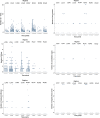Perioperative lung ultrasonography in healthy horses undergoing general anesthesia for elective surgery
- PMID: 35322893
- PMCID: PMC9151480
- DOI: 10.1111/jvim.16408
Perioperative lung ultrasonography in healthy horses undergoing general anesthesia for elective surgery
Abstract
Background: Lung ultrasound (LUS) is poorly evaluated in horses, especially perioperatively.
Objectives: (1) Describe LUS findings in healthy horses before and after general anesthesia (GA), (2) evaluate if GA induces ultrasonographic changes in healthy horses, (3) suggest a LUS scoring system, (4) identify horse variables that are associated to LUS changes after anesthesia.
Animals: Twenty-five healthy adult horses undergoing elective surgery.
Methods: Prospective hypothesis-driven observational study. LUS findings were recorded before anesthesia, 5 minutes in recovery, 15 minutes, 2H, 3H, 4H, 6H, and 24H after anesthesia in 8 lung regions. Clinical data were collected perioperatively.
Results: There was a significant increase in amount of I-lines (10.8 ± 8.7 vs 15.28 ± 8.19), B-lines (3.2 ± 3.5 vs 8.72 ± 4.86), and coalescent B-lines (0.04 ± 0.2 vs 1.12 ± 1.45) after anesthesia compared to before anesthesia, and a significantly higher LUS score 2H after anesthesia (4.92 ± 8.40) compared to before anesthesia (0.9 ± 1.8; P = .02). The maximal LUS score after anesthesia was correlated to total procedure time (Pearson r = 0.4, P = .05; Spearman r = 0.44, P = .03) and was significantly higher in horses with abnormal cardiorespiratory values during anesthesia (P = .005).
Conclusions: LUS changes can be induced by GA in healthy horses. This study did not investigate if and which LUS findings indicate lesions, however, this information can aid clinicians to identify pulmonary complications after anesthesia.
Keywords: atelectasis; equine; postoperative; pulmonary; ultrasound.
© 2022 The Authors. Journal of Veterinary Internal Medicine published by Wiley Periodicals LLC on behalf of American College of Veterinary Internal Medicine.
Conflict of interest statement
Authors declare no conflict of interest.
Figures




Similar articles
-
General anesthesia does not induce ultrasonographic changes in the pleura of healthy adult horses anesthetized for elective magnetic resonance imaging.J Am Vet Med Assoc. 2023 Feb 7;261(4):500-504. doi: 10.2460/javma.22.12.0550. Print 2023 Apr 1. J Am Vet Med Assoc. 2023. PMID: 36753394
-
Perioperative lung ultrasound pattern changes in patients undergoing gynecological procedures - a prospective observational study.Ginekol Pol. 2021;92(4):271-277. doi: 10.5603/GP.a2021.0017. Epub 2021 Mar 23. Ginekol Pol. 2021. PMID: 33757148
-
Performance of Lung Ultrasound in Detecting Peri-Operative Atelectasis after General Anesthesia.Ultrasound Med Biol. 2016 Dec;42(12):2775-2784. doi: 10.1016/j.ultrasmedbio.2016.06.010. Epub 2016 Sep 14. Ultrasound Med Biol. 2016. PMID: 27639431
-
Lung Ultrasonography for the Assessment of Perioperative Atelectasis: A Pilot Feasibility Study.Anesth Analg. 2017 Feb;124(2):494-504. doi: 10.1213/ANE.0000000000001603. Anesth Analg. 2017. PMID: 27669555
-
Perioperative Lung Ultrasound Findings in Elective Intra-Abdominal Surgery: Associations with Postoperative Pulmonary Complications.J Clin Med. 2024 Nov 24;13(23):7098. doi: 10.3390/jcm13237098. J Clin Med. 2024. PMID: 39685557 Free PMC article.
Cited by
-
Road transportation is associated with decreased intestinal motility in horses.Front Vet Sci. 2025 Aug 18;12:1647236. doi: 10.3389/fvets.2025.1647236. eCollection 2025. Front Vet Sci. 2025. PMID: 40901066 Free PMC article.
-
Survey of the approach to the diagnosis and management of bacterial pneumonia in adult horses by equine veterinarians.Front Vet Sci. 2024 Dec 23;11:1484970. doi: 10.3389/fvets.2024.1484970. eCollection 2024. Front Vet Sci. 2024. PMID: 39764370 Free PMC article.
-
Decision Making in Severe Equine Asthma-Diagnosis and Monitoring.Animals (Basel). 2023 Dec 16;13(24):3872. doi: 10.3390/ani13243872. Animals (Basel). 2023. PMID: 38136909 Free PMC article. Review.
-
Caudal vena cava isolation using ablation index-guided radiofrequency catheter ablation (CARTO™ 3) to treat sustained atrial tachycardia in horses.J Vet Intern Med. 2025 Jan-Feb;39(1):e17251. doi: 10.1111/jvim.17251. Epub 2024 Nov 30. J Vet Intern Med. 2025. PMID: 39614765 Free PMC article.
References
-
- Touw HR, Tuinman PR, Gelissen HP, Lust E, Elbers PW. Lung ultrasound: routine practice for the next generation of internists. Neth J Med. 2015;73:100‐107. - PubMed
-
- Morresey PR. Ultrasonography of the pleural cavity, lung, and diaphragm. In: Kidd JA, Lu KO, Frazer ML, eds. Atlas of Equine Ultrasonography. Chichester: Wiley‐Blackwell; 2014:367‐379.
-
- Raphel C, Beech C. Pleuritis secondary to pneumonia or lung abscessation in 90 horses. J Vet Med Assoc. 1982;181:808‐810. - PubMed

